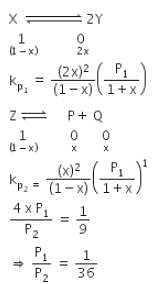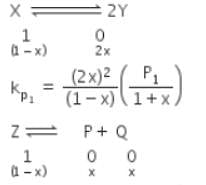Class 11 Exam > Class 11 Questions > The equilibrium constants Kp1 and Kp2 for the...
Start Learning for Free
The equilibrium constants Kp1 and Kp2 for the reactions X  2Y and Z
2Y and Z  P + Q, respectively are in the ratio of 1 : 9. If the degree of dissociation of X and Z be equal then the ratio of total pressures at these equilibria is - [AIEEE 2008]
P + Q, respectively are in the ratio of 1 : 9. If the degree of dissociation of X and Z be equal then the ratio of total pressures at these equilibria is - [AIEEE 2008]
- a)1 : 1
- b)1 : 3
- c)1 : 9
- d)1 :36
Correct answer is option 'D'. Can you explain this answer?
| FREE This question is part of | Download PDF Attempt this Test |
Verified Answer
The equilibrium constants Kp1 and Kp2 for the reactions X 2Y and Z P ...

Most Upvoted Answer
The equilibrium constants Kp1 and Kp2 for the reactions X 2Y and Z P ...
To solve this problem, we need to understand the concept of equilibrium constants and the relationship between the degree of dissociation and the total pressure.
Equilibrium Constants:
The equilibrium constant, Kp, for a reaction is a measure of the extent to which the reactants are converted into products at equilibrium. It is defined as the ratio of the partial pressures of the products to the partial pressures of the reactants, each raised to the power of their stoichiometric coefficients.
Degree of Dissociation:
The degree of dissociation, α, is a measure of the extent to which a compound dissociates into its constituent atoms or ions in a chemical reaction. It is defined as the ratio of the number of moles of the compound dissociated to the initial number of moles of the compound.
Ratio of Equilibrium Constants:
Given that the equilibrium constants Kp1 and Kp2 for the reactions X 2Y and Z P Q, respectively, are in the ratio of 1:9, we can write the following equation:
Kp2 = Kp1^2
This equation shows that the equilibrium constant for the reaction Z P Q is nine times greater than the equilibrium constant for the reaction X 2Y.
Equilibrium Constants:
The equilibrium constant, Kp, for a reaction is a measure of the extent to which the reactants are converted into products at equilibrium. It is defined as the ratio of the partial pressures of the products to the partial pressures of the reactants, each raised to the power of their stoichiometric coefficients.
Degree of Dissociation:
The degree of dissociation, α, is a measure of the extent to which a compound dissociates into its constituent atoms or ions in a chemical reaction. It is defined as the ratio of the number of moles of the compound dissociated to the initial number of moles of the compound.
Ratio of Equilibrium Constants:
Given that the equilibrium constants Kp1 and Kp2 for the reactions X 2Y and Z P Q, respectively, are in the ratio of 1:9, we can write the following equation:
Kp2 = Kp1^2
This equation shows that the equilibrium constant for the reaction Z P Q is nine times greater than the equilibrium constant for the reaction X 2Y.
Free Test
FREE
| Start Free Test |
Community Answer
The equilibrium constants Kp1 and Kp2 for the reactions X 2Y and Z P ...


Attention Class 11 Students!
To make sure you are not studying endlessly, EduRev has designed Class 11 study material, with Structured Courses, Videos, & Test Series. Plus get personalized analysis, doubt solving and improvement plans to achieve a great score in Class 11.

|
Explore Courses for Class 11 exam
|

|
Similar Class 11 Doubts
The equilibrium constants Kp1 and Kp2 for the reactions X 2Y and Z P + Q, respectively are in the ratio of 1 : 9. If the degree of dissociation of X and Z be equal then the ratio of total pressures at these equilibria is - [AIEEE 2008] a)1 : 1b)1 : 3c)1 : 9d)1 :36Correct answer is option 'D'. Can you explain this answer?
Question Description
The equilibrium constants Kp1 and Kp2 for the reactions X 2Y and Z P + Q, respectively are in the ratio of 1 : 9. If the degree of dissociation of X and Z be equal then the ratio of total pressures at these equilibria is - [AIEEE 2008] a)1 : 1b)1 : 3c)1 : 9d)1 :36Correct answer is option 'D'. Can you explain this answer? for Class 11 2024 is part of Class 11 preparation. The Question and answers have been prepared according to the Class 11 exam syllabus. Information about The equilibrium constants Kp1 and Kp2 for the reactions X 2Y and Z P + Q, respectively are in the ratio of 1 : 9. If the degree of dissociation of X and Z be equal then the ratio of total pressures at these equilibria is - [AIEEE 2008] a)1 : 1b)1 : 3c)1 : 9d)1 :36Correct answer is option 'D'. Can you explain this answer? covers all topics & solutions for Class 11 2024 Exam. Find important definitions, questions, meanings, examples, exercises and tests below for The equilibrium constants Kp1 and Kp2 for the reactions X 2Y and Z P + Q, respectively are in the ratio of 1 : 9. If the degree of dissociation of X and Z be equal then the ratio of total pressures at these equilibria is - [AIEEE 2008] a)1 : 1b)1 : 3c)1 : 9d)1 :36Correct answer is option 'D'. Can you explain this answer?.
The equilibrium constants Kp1 and Kp2 for the reactions X 2Y and Z P + Q, respectively are in the ratio of 1 : 9. If the degree of dissociation of X and Z be equal then the ratio of total pressures at these equilibria is - [AIEEE 2008] a)1 : 1b)1 : 3c)1 : 9d)1 :36Correct answer is option 'D'. Can you explain this answer? for Class 11 2024 is part of Class 11 preparation. The Question and answers have been prepared according to the Class 11 exam syllabus. Information about The equilibrium constants Kp1 and Kp2 for the reactions X 2Y and Z P + Q, respectively are in the ratio of 1 : 9. If the degree of dissociation of X and Z be equal then the ratio of total pressures at these equilibria is - [AIEEE 2008] a)1 : 1b)1 : 3c)1 : 9d)1 :36Correct answer is option 'D'. Can you explain this answer? covers all topics & solutions for Class 11 2024 Exam. Find important definitions, questions, meanings, examples, exercises and tests below for The equilibrium constants Kp1 and Kp2 for the reactions X 2Y and Z P + Q, respectively are in the ratio of 1 : 9. If the degree of dissociation of X and Z be equal then the ratio of total pressures at these equilibria is - [AIEEE 2008] a)1 : 1b)1 : 3c)1 : 9d)1 :36Correct answer is option 'D'. Can you explain this answer?.
Solutions for The equilibrium constants Kp1 and Kp2 for the reactions X 2Y and Z P + Q, respectively are in the ratio of 1 : 9. If the degree of dissociation of X and Z be equal then the ratio of total pressures at these equilibria is - [AIEEE 2008] a)1 : 1b)1 : 3c)1 : 9d)1 :36Correct answer is option 'D'. Can you explain this answer? in English & in Hindi are available as part of our courses for Class 11.
Download more important topics, notes, lectures and mock test series for Class 11 Exam by signing up for free.
Here you can find the meaning of The equilibrium constants Kp1 and Kp2 for the reactions X 2Y and Z P + Q, respectively are in the ratio of 1 : 9. If the degree of dissociation of X and Z be equal then the ratio of total pressures at these equilibria is - [AIEEE 2008] a)1 : 1b)1 : 3c)1 : 9d)1 :36Correct answer is option 'D'. Can you explain this answer? defined & explained in the simplest way possible. Besides giving the explanation of
The equilibrium constants Kp1 and Kp2 for the reactions X 2Y and Z P + Q, respectively are in the ratio of 1 : 9. If the degree of dissociation of X and Z be equal then the ratio of total pressures at these equilibria is - [AIEEE 2008] a)1 : 1b)1 : 3c)1 : 9d)1 :36Correct answer is option 'D'. Can you explain this answer?, a detailed solution for The equilibrium constants Kp1 and Kp2 for the reactions X 2Y and Z P + Q, respectively are in the ratio of 1 : 9. If the degree of dissociation of X and Z be equal then the ratio of total pressures at these equilibria is - [AIEEE 2008] a)1 : 1b)1 : 3c)1 : 9d)1 :36Correct answer is option 'D'. Can you explain this answer? has been provided alongside types of The equilibrium constants Kp1 and Kp2 for the reactions X 2Y and Z P + Q, respectively are in the ratio of 1 : 9. If the degree of dissociation of X and Z be equal then the ratio of total pressures at these equilibria is - [AIEEE 2008] a)1 : 1b)1 : 3c)1 : 9d)1 :36Correct answer is option 'D'. Can you explain this answer? theory, EduRev gives you an
ample number of questions to practice The equilibrium constants Kp1 and Kp2 for the reactions X 2Y and Z P + Q, respectively are in the ratio of 1 : 9. If the degree of dissociation of X and Z be equal then the ratio of total pressures at these equilibria is - [AIEEE 2008] a)1 : 1b)1 : 3c)1 : 9d)1 :36Correct answer is option 'D'. Can you explain this answer? tests, examples and also practice Class 11 tests.

|
Explore Courses for Class 11 exam
|

|
Signup for Free!
Signup to see your scores go up within 7 days! Learn & Practice with 1000+ FREE Notes, Videos & Tests.
























